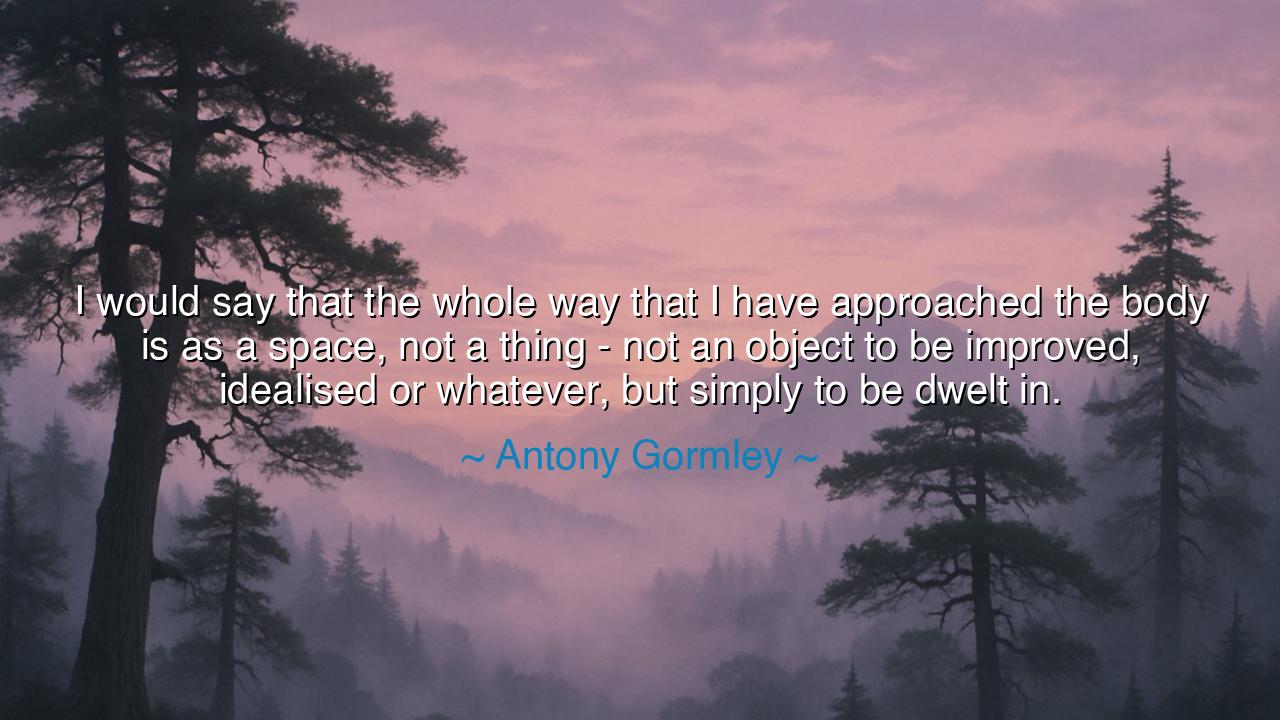
I would say that the whole way that I have approached the body is
I would say that the whole way that I have approached the body is as a space, not a thing - not an object to be improved, idealised or whatever, but simply to be dwelt in.






Hear the voice of Antony Gormley, sculptor of the human form, who declared: “I would say that the whole way that I have approached the body is as a space, not a thing—not an object to be improved, idealised or whatever, but simply to be dwelt in.” In these words lies a wisdom older than marble, older than bronze, older than any temple built by human hands. He reminds us that the body is not a mere object, to be polished and perfected like a statue for display, but a living dwelling, a vessel of spirit, a space in which the soul moves and abides.
The origin of this truth is found in both art and philosophy. Since antiquity, men have sought to idealize the human body. The Greeks carved their gods into stone with perfect proportions, the Renaissance masters painted flesh as though it were divine geometry. Yet in this pursuit of perfection, the body was often treated as an object—a thing to be admired, corrected, measured against ideals. Gormley’s insight rebels against this tradition. He seeks not the ideal, but the real; not the polished exterior, but the interior experience. To him, the body is not a monument, but a space to be dwelt in—like a home, imperfect but sacred.
Consider the tale of Diogenes the Cynic, who lived not in palaces nor adorned himself with fine clothes, but dwelt in simplicity, even in a barrel. To him, the body was not to be decorated or paraded, but to be inhabited with honesty. He mocked the pursuit of vanity, and in doing so revealed a deeper truth: man is not defined by the perfection of his body, but by how he lives within it. In this way, Diogenes and Gormley, though centuries apart, speak the same language—the body is not an idol, but a dwelling place.
And think, too, of the holy ascetics, who withdrew into the desert, forsaking adornment and comfort. They did not despise the body, but they treated it as a vessel of presence, a space where silence, prayer, and vision could take root. They did not seek to make it beautiful to the eye of man, but open to the eye of eternity. Gormley echoes this ancient wisdom in his art: the human figure becomes not an ornament but a container, a hollow form through which one may feel the vastness of existence.
But mark this well: to see the body as a space is not to despise it, but to honor it more deeply. For if it is space, then it is dwelling; if it is dwelling, then it is home; and if it is home, then it must be lived in with care. To treat the body only as an object is to miss its mystery; to live in it as space is to accept its limits and cherish its presence. This frees us from endless striving for perfection and allows us to walk in gratitude for the miracle of embodiment itself.
The lesson for us is clear. Do not despise your body for its imperfections, nor enslave yourself to endless comparisons. See it instead as the dwelling of your life—a temple, not for worship of beauty, but for the practice of being. Dwell in it as you would dwell in a sacred house: with reverence, with acceptance, with presence. Care for it, yes, but not to make it an idol—rather to keep it strong as the vessel that carries you through your days.
Therefore, O listener, remember Gormley’s wisdom: the body is not a thing, but a space. Do not live outside yourself, forever reaching for ideals that others have cast upon you. Live within yourself, and inhabit your body fully. Walk with it, rest within it, breathe through it as though you are dwelling in a holy chamber. For in the end, all works of art will crumble, but this space—the body you dwell in—will be your one true home until your final breath.






AAdministratorAdministrator
Welcome, honored guests. Please leave a comment, we will respond soon